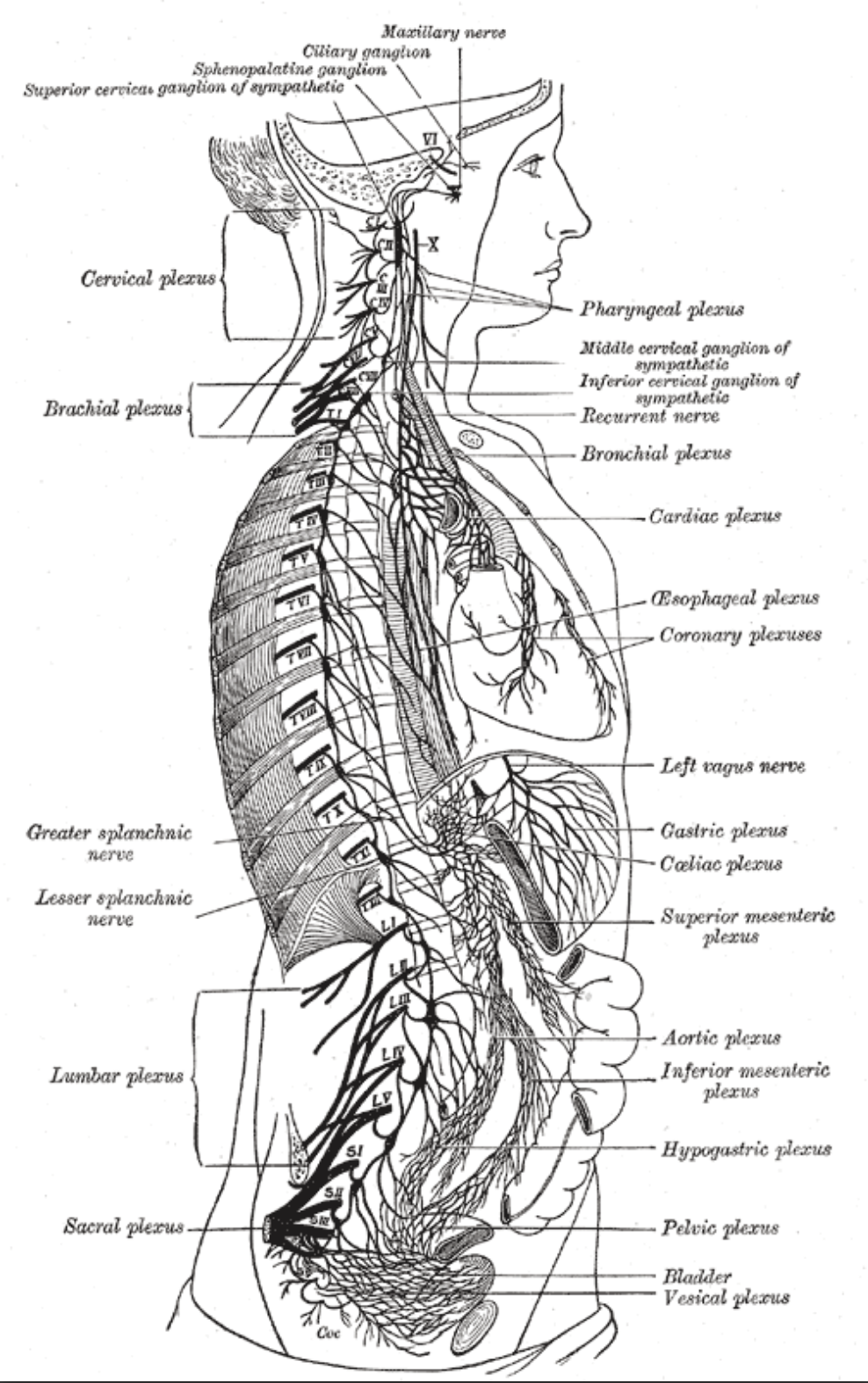[1]
Gilbey MP, Spyer KM. Essential organization of the sympathetic nervous system. Bailliere's clinical endocrinology and metabolism. 1993 Apr:7(2):259-78
[PubMed PMID: 8098208]
[2]
Sternbach JM, DeCamp MM. Targeting the Sympathetic Chain for Primary Hyperhidrosis: An Evidence-Based Review. Thoracic surgery clinics. 2016 Nov:26(4):407-420. doi: 10.1016/j.thorsurg.2016.06.005. Epub 2016 Aug 4
[PubMed PMID: 27692199]
[4]
Chaudhry A, Kamali A, Herzka DA, Wang KC, Carrino JA, Blitz AM. Detection of the Stellate and Thoracic Sympathetic Chain Ganglia with High-Resolution 3D-CISS MR Imaging. AJNR. American journal of neuroradiology. 2018 Aug:39(8):1550-1554. doi: 10.3174/ajnr.A5698. Epub 2018 May 31
[PubMed PMID: 29853521]
[5]
Narouze S. Ultrasound-guided stellate ganglion block: safety and efficacy. Current pain and headache reports. 2014 Jun:18(6):424. doi: 10.1007/s11916-014-0424-5. Epub
[PubMed PMID: 24760493]
[6]
Yokota H, Mukai H, Hattori S, Yamada K, Anzai Y, Uno T. MR Imaging of the Superior Cervical Ganglion and Inferior Ganglion of the Vagus Nerve: Structures That Can Mimic Pathologic Retropharyngeal Lymph Nodes. AJNR. American journal of neuroradiology. 2018 Jan:39(1):170-176. doi: 10.3174/ajnr.A5434. Epub 2017 Nov 9
[PubMed PMID: 29122764]
[7]
Fazliogullari Z, Kilic C, Karabulut AK, Yazar F. A morphometric analysis of the superior cervical ganglion and its surrounding structures. Surgical and radiologic anatomy : SRA. 2016 Apr:38(3):299-302. doi: 10.1007/s00276-015-1551-3. Epub 2015 Sep 12
[PubMed PMID: 26364034]
[8]
Yin Z, Yin J, Cai J, Sui T, Cao X. Neuroanatomy and clinical analysis of the cervical sympathetic trunk and longus colli. Journal of biomedical research. 2015 Nov:29(6):501-7. doi: 10.7555/JBR.29.20150047. Epub 2015 Oct 30
[PubMed PMID: 26668584]
[9]
Kwon OJ, Pendekanti S, Fox JN, Yanagawa J, Fishbein MC, Shivkumar K, Lambert HW, Ajijola OA. Morphological Spectra of Adult Human Stellate Ganglia: Implications for Thoracic Sympathetic Denervation. Anatomical record (Hoboken, N.J. : 2007). 2018 Jul:301(7):1244-1250. doi: 10.1002/ar.23797. Epub 2018 Feb 28
[PubMed PMID: 29451372]
[11]
Reede DL, Garcon E, Smoker WR, Kardon R. Horner's syndrome: clinical and radiographic evaluation. Neuroimaging clinics of North America. 2008 May:18(2):369-85, xi. doi: 10.1016/j.nic.2007.11.003. Epub
[PubMed PMID: 18466837]
[12]
Garbo GM,Harmatz AJ,Isaacson G, Incomplete Horner syndrome: Report of a case and description of the sympathetic nervous system anatomy involved in Horner syndrome. Ear, nose,
[PubMed PMID: 21328216]
Level 3 (low-level) evidence
[13]
Lumb R, Schwarz Q. Sympathoadrenal neural crest cells: the known, unknown and forgotten? Development, growth & differentiation. 2015 Feb:57(2):146-57. doi: 10.1111/dgd.12189. Epub 2015 Jan 10
[PubMed PMID: 25581786]
[14]
Bohuslavova R, Cerychova R, Papousek F, Olejnickova V, Bartos M, Görlach A, Kolar F, Sedmera D, Semenza GL, Pavlinkova G. HIF-1α is required for development of the sympathetic nervous system. Proceedings of the National Academy of Sciences of the United States of America. 2019 Jul 2:116(27):13414-13423. doi: 10.1073/pnas.1903510116. Epub 2019 Jun 13
[PubMed PMID: 31196952]
[15]
Tubbs RS, Salter G, Wellons JC 3rd, Oakes WJ. Blood supply of the human cervical sympathetic chain and ganglia. European journal of morphology. 2002 Dec:40(5):283-8
[PubMed PMID: 15101443]
[16]
Kiray A,Arman C,Naderi S,Güvencer M,Korman E, Surgical anatomy of the cervical sympathetic trunk. Clinical anatomy (New York, N.Y.). 2005 Apr;
[PubMed PMID: 15768422]
[17]
Civelek E, Karasu A, Cansever T, Hepgul K, Kiris T, Sabanci A, Canbolat A. Surgical anatomy of the cervical sympathetic trunk during anterolateral approach to cervical spine. European spine journal : official publication of the European Spine Society, the European Spinal Deformity Society, and the European Section of the Cervical Spine Research Society. 2008 Aug:17(8):991-5. doi: 10.1007/s00586-008-0696-8. Epub 2008 Jun 12
[PubMed PMID: 18548289]
[18]
Balak N, Baran O, Denli Yalvac ES, Esen Aydin A, Tanriover N. Surgical technique for the protection of the cervical sympathetic trunk in anterolateral oblique corpectomy: A new cadaveric demonstration. Journal of clinical neuroscience : official journal of the Neurosurgical Society of Australasia. 2019 May:63():267-271. doi: 10.1016/j.jocn.2019.01.019. Epub 2019 Feb 1
[PubMed PMID: 30718131]
[19]
Pather N, Partab P, Singh B, Satyapal KS. The sympathetic contributions to the cardiac plexus. Surgical and radiologic anatomy : SRA. 2003 Jul-Aug:25(3-4):210-5
[PubMed PMID: 12904902]
[20]
Kawashima Y, Sumi T, Sugimoto T, Kishimoto S. First-bite syndrome: a review of 29 patients with parapharyngeal space tumor. Auris, nasus, larynx. 2008 Mar:35(1):109-13
[PubMed PMID: 17851003]
[21]
Borràs-Perera M, Fortuny-Llanses JC, Palomar-Asenjo V, Palomar-García V. [First-bite syndrome]. Acta otorrinolaringologica espanola. 2009 Mar-Apr:60(2):144-5
[PubMed PMID: 19401083]
[22]
Prim MP, De Diego JI, Verdaguer JM, Sastre N, Rabanal I. Neurological complications following functional neck dissection. European archives of oto-rhino-laryngology : official journal of the European Federation of Oto-Rhino-Laryngological Societies (EUFOS) : affiliated with the German Society for Oto-Rhino-Laryngology - Head and Neck Surgery. 2006 May:263(5):473-6
[PubMed PMID: 16380807]
[23]
Linkov G, Morris LG, Shah JP, Kraus DH. First bite syndrome: incidence, risk factors, treatment, and outcomes. The Laryngoscope. 2012 Aug:122(8):1773-8. doi: 10.1002/lary.23372. Epub 2012 May 9
[PubMed PMID: 22573579]

